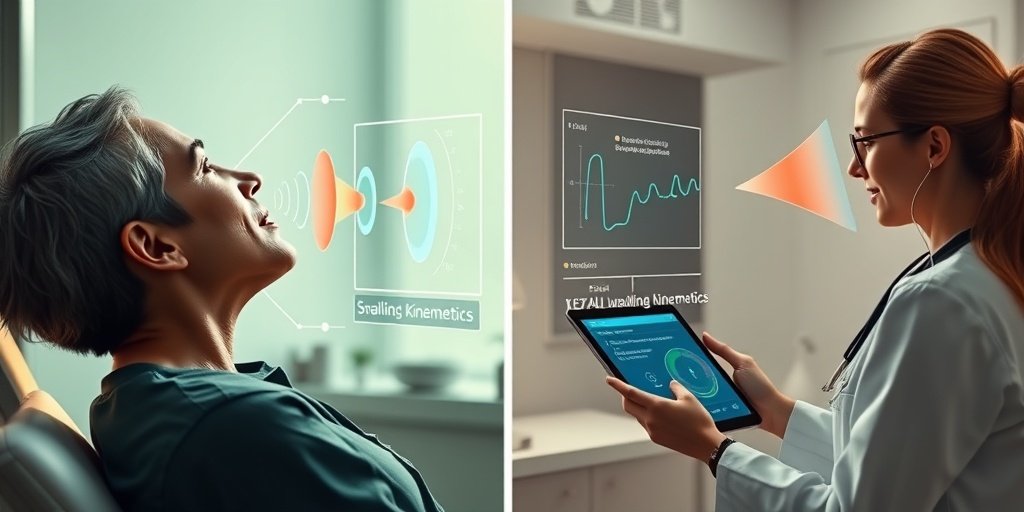⚡ Quick Summary
This study introduces a non-invasive integrated swallowing kinematic analysis framework utilizing transformer-based multi-task neural networks to analyze swallowing kinematics from high-resolution cervical auscultation (HRCA) signals. The framework achieved an impressive 92% accuracy and demonstrated strong generalization capabilities across different patient cohorts.
🔍 Key Details
- 📊 Dataset: HRCA signals from 120 patients
- 🧩 Features used: Swallowing kinematic landmarks
- ⚙️ Technology: Transformer-based multi-task neural networks
- 🏆 Performance: 92% accuracy, 89% sensitivity, 92% specificity
🔑 Key Takeaways
- 📊 Non-invasive analysis of swallowing kinematics is now possible with HRCA.
- 💡 Multi-task learning enhances the analysis of multiple swallowing parameters simultaneously.
- 👩🔬 Framework outperformed existing state-of-the-art models in swallowing assessment.
- 🏆 Achieved over 85% accuracy on an independent dataset.
- 🌟 Key components analyzed include upper esophageal sphincter opening duration and hyoid bone displacement.
- 🗣️ Aids speech-language pathologists in diagnosing swallowing impairments.
- 📈 Strong generalization capabilities across different patient cohorts.
- 🔬 Study published in the journal Comput Biol Med.

📚 Background
Swallowing disorders can significantly impact an individual’s quality of life, making accurate assessment crucial for effective treatment. Traditional methods, such as videofluoroscopic swallowing studies (VFSS), while effective, involve radiation exposure and can be invasive. The exploration of high-resolution cervical auscultation (HRCA) as a non-invasive alternative presents an exciting opportunity to enhance swallowing assessments without the associated risks.
🗒️ Study
This study aimed to develop a comprehensive framework for analyzing swallowing kinematics using HRCA signals. By employing shared parameter multi-task learning with transformer encoders, researchers trained the framework on HRCA data from 120 patients, labeled by speech-language pathologists, to evaluate multiple swallowing kinematic landmarks simultaneously.
📈 Results
The proposed framework demonstrated remarkable performance, achieving a 92% accuracy, 89% sensitivity, and 92% specificity during a 10-fold cross-validation procedure. Furthermore, it maintained over 85% accuracy when tested on an independent dataset, showcasing its robust generalization capabilities and surpassing existing models in the literature for individual task detection in swallowing assessment.
🌍 Impact and Implications
The implications of this study are profound. By providing a detailed and objective analysis of swallowing kinematics, the framework can significantly aid speech-language pathologists in diagnosing swallowing impairments. This non-invasive approach not only enhances patient safety but also opens new avenues for research and clinical practice in the field of dysphagia management.
🔮 Conclusion
This study highlights the potential of transformer-based multi-task neural networks in revolutionizing swallowing assessments. The ability to conduct a comprehensive analysis of swallowing parameters non-invasively could lead to improved diagnostic accuracy and patient outcomes. As we continue to explore the integration of advanced technologies in healthcare, the future looks promising for swallowing disorder management.
💬 Your comments
What are your thoughts on this innovative approach to swallowing assessment? We would love to hear your insights! 💬 Leave your comments below or connect with us on social media:
Non-invasive integrated swallowing kinematic analysis framework leveraging transformer-based multi-task neural networks.
Abstract
BACKGROUND: Swallow kinematic analysis is the process of evaluating the physiological attributes of swallowing. Although videofluoroscopic swallowing studies (VFSS) are the gold standard, non-invasive and radiation-free high-resolution cervical auscultation (HRCA) has been extensively studied as a potential alternative. HRCA has been effectively employed for individual kinematic analysis tasks, but its application to conduct a comprehensive multitask analysis has not yet been explored.
METHODS: In this study, we use shared parameter multi-task learning with transformer encoders to develop an integrated swallow kinematic analysis framework using sensory information presented in HRCA signals. We used HRCA signals recorded from 120 patients and labeled by speech-language pathologists to train and evaluate the framework. This framework analyzes multiple swallowing kinematics landmarks from individual swallows within HRCA signals.
RESULTS: The proposed framework achieved 92% accuracy, 89% sensitivity, and 92% specificity in a 10-fold cross-validation procedure over the main dataset, and maintained over 85% accuracy when tested on a never-seen independent dataset collected from a different cohort of subjects. These results not only demonstrate strong generalization capabilities but also outperform all state-of-the-art and baseline models reported in the literature for individual task detection in swallowing assessment.
CONCLUSION: The results indicate that the multi-task framework provides a detailed and objective analysis of key components of swallowing such as upper esophageal sphincter opening duration and distension, laryngeal vestibule closure duration, and hyoid bone displacement with comparable performance to single-task detection algorithms and VFSS-based human ratings. Finally, we presume that the comprehensive swallowing parameter analysis would help speech-language pathologists in the process of decision making and diagnosis of swallowing impairments.
Author: [‘Anwar A’, ‘Khalifa Y’, ‘Lucatorto E’, ‘Coyle JL’, ‘Sejdic E’]
Journal: Comput Biol Med
Citation: Anwar A, et al. Non-invasive integrated swallowing kinematic analysis framework leveraging transformer-based multi-task neural networks. Non-invasive integrated swallowing kinematic analysis framework leveraging transformer-based multi-task neural networks. 2025; 196:110887. doi: 10.1016/j.compbiomed.2025.110887